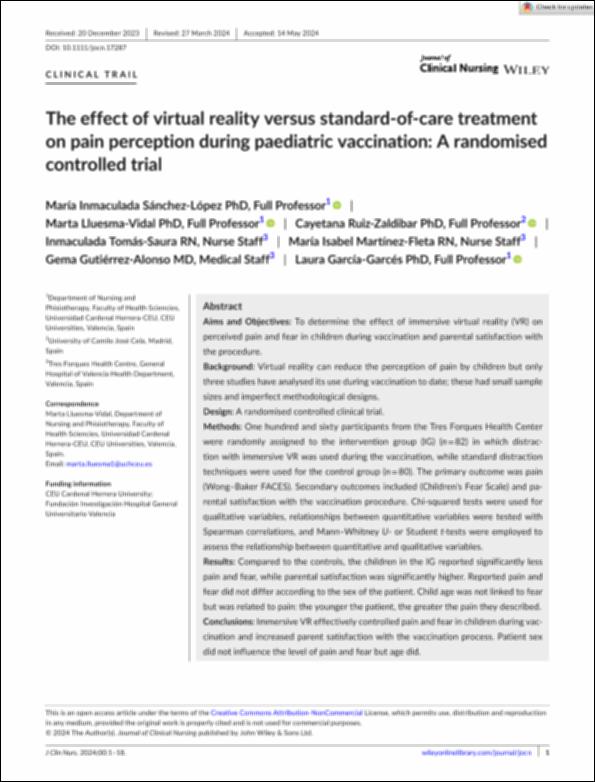Please use this identifier to cite or link to this item:
http://hdl.handle.net/10637/16145The effect of virtual reality versus standard-of-care treatment on pain perception during paediatric vaccination: a randomised controlled trial
| Title: | The effect of virtual reality versus standard-of-care treatment on pain perception during paediatric vaccination: a randomised controlled trial |
| Authors : | Sánchez López, María Inmaculada Lluesma Vidal, Marta Ruiz Zaldibar, Cayetana Tomás Saura, Inmaculada Martínez Fleta, María Isabel Gutiérrez Alonso, Gema García Garcés, Laura |
| Keywords: | Vacunación; Vaccination; Percepción; Perception; Niño; Children; Dolor; Pain; Miedo; Fear; Realidad virtual; Virtual reality; Tratamiento médico; Medical treatment |
| Publisher: | John Wiley & Sons |
| Citation: | Sánchez-López, M.I., Lluesma-Vidal, M., Ruiz-Zaldibar, C., Tomás-Saura, I., Martínez-Fleta, M.I., Gutiérrez-Alonso, G. & García-Garcés, L. (2024). The effect of virtual reality versus standard-of-care treatment on pain perception during paediatric vaccination: a randomised controlled trial. Journal of Clinical Nursing, Advance online publication. DOI: https://doi.org/10.1111/jocn.17287 |
| Abstract: | Aims and Objectives: To determine the effect of immersive virtual reality (VR) on perceived pain and fear in children during vaccination and parental satisfaction with the procedure. Background: Virtual reality can reduce the perception of pain by children but only three studies have analysed its use during vaccination to date; these had small sample sizes and imperfect methodological designs. Design: A randomised controlled clinical trial. Methods: One hundred and sixty participants from the Tres Forques Health Center were randomly assigned to the intervention group (IG) (n = 82) in which distraction with immersive VR was used during the vaccination, while standard distraction techniques were used for the control group (n = 80). The primary outcome was pain (Wong–Baker FACES). Secondary outcomes included (Children's Fear Scale) and parental satisfaction with the vaccination procedure. Chi-squared tests were used for qualitative variables, relationships between quantitative variables were tested with Spearman correlations, and Mann–Whitney U- or Student t-tests were employed to assess the relationship between quantitative and qualitative variables. Results: Compared to the controls, the children in the IG reported significantly less pain and fear, while parental satisfaction was significantly higher. Reported pain and fear did not differ according to the sex of the patient. Child age was not linked to fear but was related to pain: the younger the patient, the greater the pain they described. Conclusions: Immersive VR effectively controlled pain and fear in children during vaccination and increased parent satisfaction with the vaccination process. Patient sex did not influence the level of pain and fear but age did. Relevance to clinical practice: Improving vaccination experiences can reduce perceived pain and fear in children and increase parent satisfaction, thereby enhancing vaccination schedule adherence and improving group immunity. Reporting Method: The CONSORT Statement for non-pharmacological randomised clinical trials were followed. |
| URI: | http://hdl.handle.net/10637/16145 |
| Rights : | http://creativecommons.org/licenses/by-nc/4.0/deed.es Open Access |
| ISSN: | 0962-1067 1365-2702 (Electrónico) |
| Issue Date: | 2024 |
| Center : | Universidad Cardenal Herrera-CEU |
| Appears in Collections: | Dpto. Enfermería y Fisioterapia |
Items in DSpace are protected by copyright, with all rights reserved, unless otherwise indicated.


